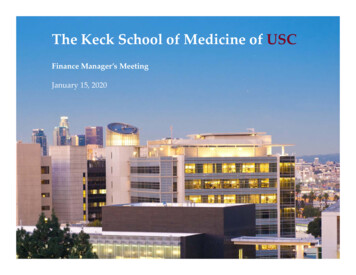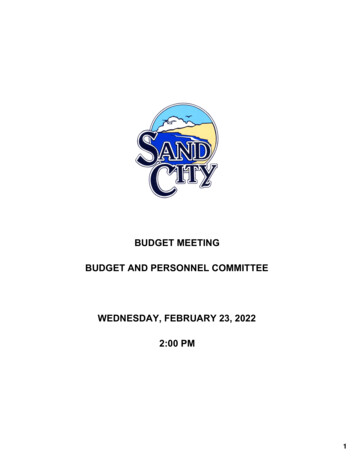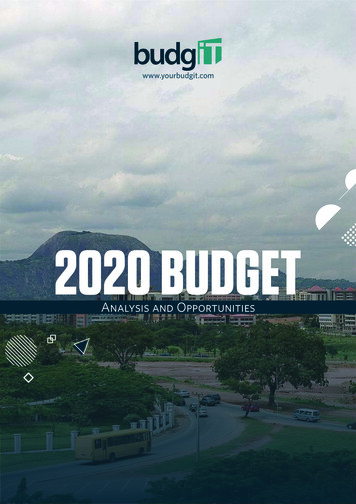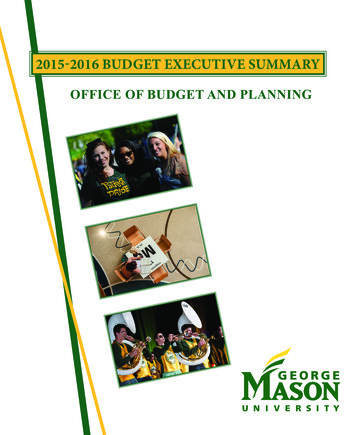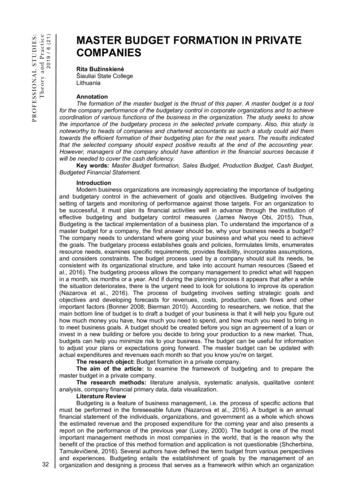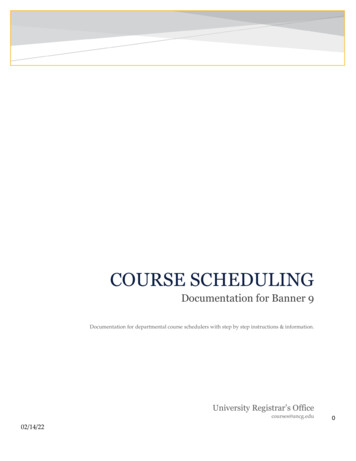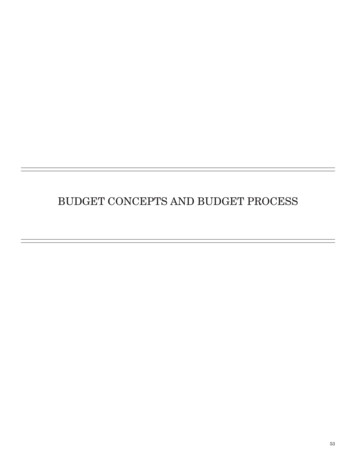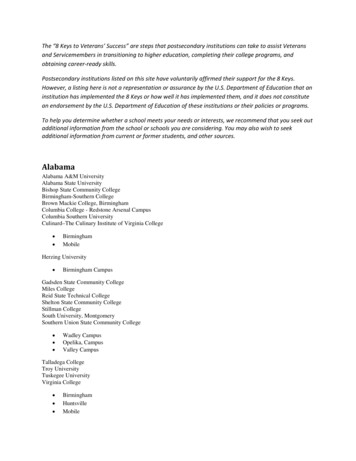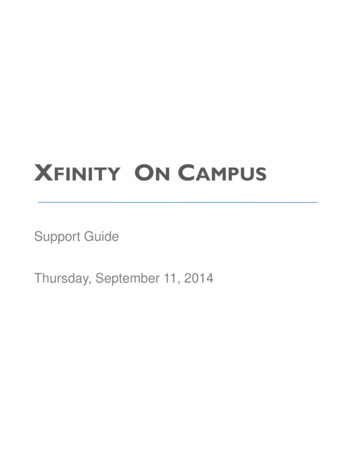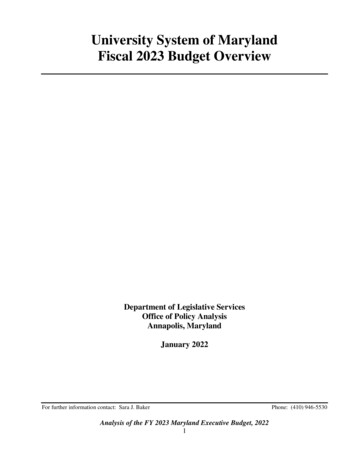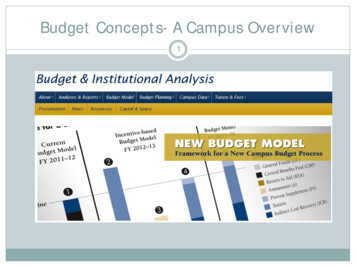
Transcription
Budget Concepts- A Campus Overview1
Agenda2Section 1: What is a budget Systemwide & Campus Perspective Budget Concepts Budget PoliciesSection 2: Establishing Budgets Reading Decision Support Reports Budget MaintenanceSection 3: ConclusionHaveFun!!
After today, the following will help you if youare able to .3 Impress your friends by explaining:ooUC systemwide budget trendsThe UC Davis budget process Converse with your neighbors on budgetaryconcepts Understand the benefit of a unit budget process
And you will be able to .4 Run and read Decision Supportbudget reports Monitor and update currentand base budgets
Introductions5 Name Department Position Years experience withCampus budgeting
6 What is a budget Systemwide & Campus Perspective Budget Concepts Budget Policies
What is a budget?7Webster’s DictionaryA plan for thecoordination ofresources andexpenditures
What is a budget?8UC DavisA plan for aligning sources (revenues) and uses(expenditures) to achieve programmatic goals.
A Plan is 9 Thoughtful and thorough Goal specific Time driven Involves data gatheringoPast and current information Includes assumptions about the future
The Nature of the Plan10 Involves many perspectiveso Examples include: Campus, staff, student,faculty, general public and outside entities Is process driveno Documentation on how the plan was createdand communicated Not Perfecto Best guesses based on historical data An ongoing process Always monitored for changes
A budget is important for:11 Prioritizing Understanding resource requirements & availability Aligning resources with priorities Cost-effective spending
A budget is essential to:12 Ensure accountability Measure effectiveness of resource management
Systemwide & Campus Perspective13
UC Davis Revenue: 4.3 billionFederal (Hatch, Pell Grants),(1%)Indirect Cost Recovery, 124(3%)Grants and Contracts, (13%)Sales and Service, Auxiliary,(12%)Gifts, Endowments, Interest,Other, (5%)State Designated andRestricted, (1%)Tuition, (11%)Student Fees ( 4%)State Unrestricted, (9%)Medical Center(41%)2015-16 Estimates
Allocating Funds15How does theUniversity get itsState GeneralFund budget?
UC Budget Process16Governor’s BudgetLegislative AnalystRecommendationsRegents ApproveBudget RequestJanuarySubcommitteeHearingsPresident Meets withDepartment of FinanceGovernor’s May ReviseFiscal YearSubcommitteeHearingsConferenceCommitteeUC DraftsBudget RequestJulyInternalConsultationsGovernor SignsSenate andAssembly Approve
How are funds allocated to the campus?17Governor / Legislative ApprovalUC Office of the PresidentUC Davis (Budget Office Allocates)Dean or Vice Chancellor OfficeDepartment
18UC DavisBudgetProcess
Budget Process Guiding Principles19 Open, understandable and fair Focus is on performance andpriorities Balanced betweencentralization anddecentralization to ensuredecisions are made as close aspossible to the programs
Budget Process20 Annual process for budgeting General Fund, tuition and IndirectCost Return. Provost/CFO provide Budget Framework letter around March thatincludes campus planning assumptions for following fiscal year. Deans/Vice Chancellors meet with Chancellor/Provost and BIA inSpring to discuss unit budgets: challenges, priorities,opportunities, initiatives. Final allocation letter released in July that includes informationabout Provost Allocation decisions and tuition revenue allocatedthrough the Budget Model.
You mentioneda Budget Model?21
Budget Model Principles22 Attribute revenue to generating unit Units more responsible for funding activities Create incentives Improve student experience Identify and pursue new revenue Manage resources with eye to long-term returns
Budget Model Principles23 Be sustainableCreate incentives that advance campus goalsBe transparentBe as simple as possible to understandBalance local autonomy with campuswide vision and valuesInclude transition strategies
Why did we make this change?25 As state support for UC has declined, campushas become increasingly dependent on fundsgenerated by campus New UCOP policy allows campus to keep therevenues that it generates.
Budget Model Implementation26 In July 2012, we implemented undergraduatetuition revenue and ICR budget models. In July 2014, we implemented Summer Session andgraduate tuition revenue budget models. Continue to review and monitor as we go along.
Where can I get more information?27Budget and Institutional odel Updates and Status ReportsOverview documentsWhite Papers – Allocation DetailsMaterials from other universitiesProvost and Executive Vice ChancellorRalph J. Hexter
Departmental Budgeting28Now that we know the campus budget process Let’s look athow a department would develop a budget.
Developing a Departmental Budget29You have been given the assignment to develop yourdepartments budget process. What steps do you thinkshould be included?15 Minutes
Order Your Steps and Match the Actions30
Order Your Steps and Match the Actions31354261
Share with the class32Based on what we justcovered What was a surprise? What was not a surprise?
Budget Concepts33
Budget Concepts341)2)3)4)5)6)7)8)Fund accountingFund typeHigher Ed function codesObject consolidation codesObject codesAppropriationsEncumbrancesBase budget vs. Current budget
1. Fund Accounting35Funds established toensure accountability andto align expenditures fordesignated purposes.“Putting transactions intobuckets”Also referred to as “colorof money”
2. Fund Type36 Funds come with a distinct purpose.(must retain its color) Different fund typeso Areaccountable to different partieso Limit how much you spendo Limit how you spend it
What are the Fund Types at UC Davis?37
Sub Fund Group Types38
Notable Funds39 General Funds and Tuition Student Services Fee Campus Based Student Fees Endowments & Gifts
Notable Funds40 Extramural activities(contracts & grants) Indirect Cost Recovery (ICR) Patent Funds Self-supporting activities
General Funds and Tuition41 General Fund (OP Fund 19900)o State Appropriationo Tuition UC General Fundso Generated by the University Non-resident tuition, application fees, portion of overhead Budget authority to spend Funds should be expended or encumbered in sameyear
Undergraduate Tuition Revenuein the Budget Model42 After Financial Aid ( 30% of tuition) and aportion of nonresident supplemental tuition: 70% to schools and colleges based on theirshare of: Student Credit Hours (60%)Majors (30%)Degrees (10%)30% to Provost (redistribute back out toacademic and administrative units).
Student Fees43 Student Fees (SFGT T)o Tuition oStudent Services Fees o ooStudent Support Services that benefit studentsProfessional School Fees oFinancial Aid19900 – General FundProfessional school operating budget supportFinancial Aid supportStudent ReferendumChancellor or RegentsList available on BIA x.html
Student Fees442015-16 Student Fees for Undergraduate California ResidentsASUCD Fee 105.00Memorial Union Fee 85.50Facilities and Campus Enhancements Fee 412.18Campus Expansion Initiative 548.81Student Services Maintenance Fee and Student 343.86Student Facilities Safety Fee 66.00Student Services Health Fee 132.00Unitrans 18.00Student Services Fee 1,020.00Tuition 11,220.00TOTAL, California Residents (excludes Health Insurance 13,951.35Activities and Services Initiative FeeHealth Insurance Fee [2] 2,115.00
Endowments and Gifts45 Endowment fundsDonor stipulates principal is to remain intact.o Only income from investment of the funds may beexpended. Gifts are funds donated for unrestricted or designatedpurposes by non-university individuals or organizations. Both are typically restricted to specific uses; ourresponsibility to use those funds consistent with thoserestrictions.o
Extramural Funds46 Funds received under grants, donations, orcontracts from sources outside the university,including federal, state, and local governmentsand private organizations. Authority to spend/commit third party fundsbased on terms of the contract or grant. Not regularly budgeted – Current Budgets Only
Indirect Cost Recovery Funds47 Overhead recoveryo Campus is reimbursed for some of the costs thecampus has incurred to support that research Based upon the amount and type of researchconducted on the campus Also referred to as Facility & Administration(F&A) Costs.
Indirect Cost Recovery FundsBudget Model Formula48 After categorical set-asides 37% to units63% to ProvostPortion to units based on administrative homeExample of set-asides Garamendi financed buildingsResearch funded by the American Recovery andReinvestment Act of 2009 (ARRA)
Patent Funds49 Royalties earned for UC Davis-sponsored inventions. UC Davis receives net patent revenue (patent revenueafter legal fees and inventor shares are deducted) andresearch share revenues from UCOP. BIA allocates 70% of net revenues to Deans andDepartments based on who earned the revenues (70% ofthese revenues go to the departments, 30% to the Dean’sOffice). 15% of net revenues go to the Office of Research tosupport patent-related activities. 15% of net revenues goes to the Provost.
Self Supporting50 Revenue generated supports the activities Budget is estimate; authority to spend basedon actual revenue Rate approval required from campus orVC/Dean’s Office.Decision Support issame as Rate Proposal Budget Base budget in KFS and
And how you spend it!!!51 Different fund types are accountable to differentparties. Example: General Funds cannot be used for:ooooDirect fund raisingSocial club membershipsAlcohol and tobaccoCapital renovations over 100,000
General Funds.52Can I pay for thiswith GeneralFunds?ComputersAlcohol
Now, You know the Fund Types53Let’s Find Out How They Relateand Where to Find Them .
It All Starts with the Office of the President (OP)54 The UC Fund (also know as the OP fund) is a five-digit number representing the source of fundingfor an account. Each UC Fund Number has:o A titleo A sub-fund group Both help to further describe the fund source.
Where can I find the UC Fund?55 A list of all the valid fund numbers can be found inthe UC Fund Number reference table in DecisionSupport (FIS 236).Or Contact General Accounting
Importance of UC Fund Numbers56 The Office of the President requiresspecific information to meet itspublic reporting needs. The UC Fund indicates both thefunding source and the specificaward.
Where to find them on Existing Accounts57Fund Information
Other Attributes: Chart58 All accounts must have a chart associated withthem. UC Davis’ accounting system includes 4 charts:ooooChartChartChartChart3: main campusS: School of Medicine and School of NursingH: HospitalL: UC Agriculture and Natural Resources
3. Other Attributes:Higher Ed Function Code (HEFC)59 A 4-digit code assigned to each account to definethe overall purpose of the account.oFirst 2 digits are derived from UC account Standardized reporting classifications for highereducationoDefined by the National Association of College andUniversity Business Officials (NACUBO).
3. Higher Ed Function Code (HEFC)60Examples: ACAD - Academic Support (43) INSP - Institutional Support (66, 72) INST - Instruction and Depart. Research (40) ORES - Organized Research (44) PBSV - Public Service (62)Categories are dictated by National Standards
3. Higher Ed Function Code (HEFC)Description of Functions61 ACAD - Academic Supporto Activities organized and operated in connection witheducational departments. LibrariesDean’s Office INSP - Institutional Supporto General administrative and service departmentsserving the University as a whole. Budget Office INST - Instruction and Depart. Researcho Instructional departments, including research done as apart of regular instructional programs GeologyMathematics
3. Higher Ed Function Code (HEFC)Description of Functions62 ORES - Organized Researcho Organized research units including researchinstitutes, centers, bureaus, laboratories and stations Bodega Marine LaboratoryCrocker Nuclear Laboratory PBSV - Public Serviceo Activities intended to serve the general public Mondavi CenterUCD Presents
Existing Account63IAMMGR
4. Object Consolidation Codes64 Divides financial activityinto categories Umbrella for object codes Useful for budget documents Helpful to summarizeexpenditures by category
4. Object Consolidation Codes65
5. Object Codes66 Object codes allow you totrack expenditures by typeof expense. Several object codes roll-up to one objectconsolidation code Required on financialtransactions
6. Appropriations are .67 Authority to spend Budgeted as a credit byobject consolidationcodes. A.K.A. Allocations
How Appropriations Show on the LedgerSpending Authority68
7. Encumbrances are.69 Funds committed but not yetpaid Not true financialtransactions Also referred to as “Liens” Recorded as a Debit byobject code Deducted from allocationswhen computing balance
Types of Encumbrances70 External Encumbrances:oOfficial university commitments generated by: A Purchase OrderDepartmental Purchase OrderDepartmental Repair Order Internal Encumbrances:oUnofficial liens, generated by: Purchase Requisitions Pre-Encumbrances:oUnofficial liens generated by: The Departmental Encumbrance documentDo not put a hold or lien on departmental funds. These encumbrancesare for information and planning purposes only.Includes Payroll liens. See here for additional info: http://afstest.ucdavis.edu/our dures/pps-encumbrance-liens.html
How Encumbrances Show on the Ledger71
8. Base vs. Current Budget72Base Budget On-going funding. Establishes annualoperating budget.Current Budget Shown on year-to-dategeneral ledger reports. Total Funds available thisyear. Includes deficit orsurplus from prior year. Changes entered this yeareffect next year’s currentbudget. Changes entered this yeareffect current yearbudget.
8. Base vs. Current Budget73
Base vs. Current Budget74Base BudgetCurrent Budget KFS BB document KFS CB document. Augmented to cover ongoing Augmented to cover currentcommitments (i.e., 12months). e.g., a merit effective10/1/13 rec’ 12 months basebudget funding. Provides starting budget fornext fiscal year.year expenses only. e.g., a merit effective10/1/13 received 9 monthsof current budget funding.
Example:75July 1, 2012Surplus from prior yearMerit- Base 12m , Current 9mJune 30, 201312-13 Expenses12-13 BalanceJuly 1, 2013Surplus from 12-13Adjusted July 1, 00137,300
Let’s Test Your Knowledge!76Does a Base Budget prepared on December 1,2014 affect fiscal year 2014-15?NOWhat year does it affect?2015-16
Would you change your BB for .?77One time start-up funding?No, one-time funding affects currentbudgets.Funding for permanent employee?Yes, permanent SUBS employees arereflected in base budgets.
Would you change your BB for .?78 Unusual equipment purchased incurrent year (SUB4), funded fromsalary savings?No, the base budget should not bechanged to reflect one-time,unusual fluctuations.
Case Study79 Let’s look at a scenario and see what we shoulddo .
What would you do?80 Your staff is swamped with work and are ready towalk out You’ve been given authority to hire additionalstaff There are current year funds available (mostlyfrom salary savings) Your base budget is fully subscribed
What can you do?81Q: Could you hire acareer employee with anindefinite end date?A: No.When a career employee ishired, the campus ismaking an indefinitecommitment. Currentyear salary savings will runout, and there will not bebase funds to pay thecareer salary.BUT you could build salarysavings into budget andfree up base funding.
Scene 2:82Q: What would be someoptions to relieveworkload?A: Use current year funds tohire a person from theTemporary EmploymentServices. Hire a person with anappointment end-date(e.g., one yearappointment).
Budgets – Now we know the difference!83Is the base budgetmagic? What base and currentbudget situations /allocations do you findunclear?
Important Budget Policies84
Current budget transfers85 A budget transaction cannotcross funding sources. Chart L cannot cross with anyother chart (3, S & H). You can cross between charts 3,H, & S as long as the account iswithin the same fund. Transfers from Location 3 (Davis)to Location L (Office of thePresident) must be processed onan interlocation transfer.
Base Budget Transfers86 Same as current budget transfersexcept: To/From accounts must have thesame higher education functioncode. Applies to accounts with general fundsor student fee funds.Contact your Dean or Vice Chancellorif needed. Contract and grant accounts arenot allowed in this document.
Base and current budgets87Only Self-Supporting funds should: Budget income (INCO) orRecharge (SUB9)
No deficit spending!88 All fund types Responsibility of financial managers
Costs most departments cover89 Salaries and Benefits Supplies - OE&E Telecommunications General Liability (GAEL) Equipment replacement
OE&E Budgets90A few words aboutOperating Expense &Equipment (OE&E)Budgets
More about OE & E budgets.91 OE & E Budget should cover:o Technology costso Job related equipment/Supplieso Office supplieso Trainingo Copier costso Maintenance/Licensingagreements Your Dean/Vice ChancellorOffice may have abenchmark.
Contracts/Grants Stop here92 Extramural Accounting willprepare current budget inKFS based upon Grantdocuments. Proposal Budgeting BasicsStaff development class.
What have we seen?93 UCD budget process Budget Concepts Budget Policies
Let’s Test your knowledge with a Matching Game94Find a friendand match the phrases
Budget Term Match95The Budget Term Match!ABase Budget Document1Authority to spendBAppropriation2Divides financial activitiy into categoriesCChocolate/Diet Coke3On-going fundingDObject Consolidation Codes4The other breakfast of championsEUC Fund5Defines overall function of an accountFAnother word for Lien6Identifies fund source for an accountGColor of Money7Funds come with a distinct purposeHHigher Ed Function Code8EncumbranceIOE&E Budget9Computers, Office Supplies
Budget Term Match - Answers96The Budget Term Match!ABase Budget Document1Authority to spendBAppropriation2Divides financial activitiy into categoriesCChocolate/Diet Coke3On-going fundingDObject Consolidation Codes4The other breakfast of championsEUC Fund5Defines overall function of an accountFAnother word for Lien6Identifies fund source for an accountGColor of Money7Funds come with a distinct purposeHHigher Ed Function Code8EncumbranceIOE&E Budget9Computers, Office Supplies
Budget and Reporting97 Establishing Budgets Reading Decision Support Reports Budget Maintenance
Why is it important to establish a budget?98General Funds and Tuition Authority to spend Operating plan Management tool Basis for someallocations Systemwide reportingSelf-Supporting Funds Basis for rates –Estimate of earnings Operating plan Management tool Systemwide Reporting
Budget Format99General Funds andTuition All appropriations area credit to expenseobject consolidationcodes.Self Supporting Income/Rechargeappropriations are adebit (from). Expense appropriationsare a credit (to).
Budget Specific Report Listing100
General Fund ExampleBase Budget Decision Support Report #59101Spending Authority
Self Supporting Fund-Example Base Budget102Income EstimateRecharge EstimateBase Budget Total is Zero
Budgets and KFS103We can Revise budgets easily Budget at various detaillevels Review reports too Compare CB to actualo Track activity CB & BB
Reading Decision Support Reports forMonitoring104Can someonehelp me readthese reports?
Decision Support Report ListingLook at All These Options!Most Used Summary Report105
Remember when reviewing Decision Supportreports106General Funds and TuitionSelf Supporting Funds Expenditures are limited Expenditures are limitedby budgets. GL reports are analyzedleft to right.(budget vs. expense)by earned revenue. GL reports are analyzeddownwards (revenue vs.expense).
General Funds and Tuition Account – Left to Right107
Self-Supporting –Top to Bottom and Left to RightYear to Date Balance108Balance includingApprop and Encum
Managerial Reports – How Can They Help?109
Managerial Reports110 FIS 190 – Organizational Expenditure Summaryo Summary by function code and organizationo One-line total for each accounto Totals at organization and function code levelso Summaries are provided by sub-fund group FIS 210 – Annual Summary by Object Groupo Percent Available or Spento Projections to Year End Based on prior year or avg.-to-date FIS 349 – Summary Sources and Uses of Fundo By SFGT, shows sources and uses of funds.o Sources broken down by carryforward, base budget, current yearadjustments, income and recharge.
Annual Summary by Object Group (FIS 210)111
Sources and Uses Summary (FIS 349)112Self-Supporting Funds (SFGT: 4,6,A,M,Y)Carryforward3,136,701.61July 1 Base Budget2,904,173.00CRCurrent Year Adjustments1,544,473.79CR12,024,843.09CRActual RevenueIncome ( INC0 )Recharge ( SUB9 )Total RevenueTotal CRExpendituresStaff Salaries ( SUBS,STFO,STFB )Leave ( SB28 )General Assistance ( SUBG )Supplies & Services ( SUB3 )Equipment ( SUB4 )Travel & Entertainment ( SUB5 )Benefits ( SUB6 )Improvements Reserve ( SB74 )Depreciation ( SB75 )Total ExpendituresSELF-SUPPORTING FUNDS: Total Funds 8.601,480,984.9867,379,518.16662,940.03OD
Do you have the whole picture?113Gasp! Is that an overdraft,or am I out of focus? Check your SUB8! Did you have any carry-forwards? SurplusesOverdrafts / Deficits Check your unexpendedbalance account! (selfsupporting units) Reappropriate fromunexpended balance tooperational accounts
Unexpended What?114For Self-Supporting accounts review your unexpendedbalance accounts
What are Unexpended Balance Accounts?115 Only for Self Supporting Activities Net Revenue (sum of all revenues, recharges andexpenses) by OP fund that is closed in to a singlebalance sheet account. Your OP Fund number “00”. Reappropriationo Net revenue is reappropriated to a Provision account oPR fund accountNew fiscal year move to operating account(s) using aCB document
Budget Maintenance116
Tips for Analyzing Financial Reports1171.Compare actual expenses for the current periodto the budgeted figures for the same period.2.Compare actual expenses for the current periodto actual expenses for the same period in theprior year.
Tips for Analyzing Financial Reports118 Look at comparisons to:ooooIdentify problem areasIdentify trendsSet new goals or revise old goalsAssign corrective actions Don’t forget to update your budgets!
Possible Corrective Actions119 Determine ifspending should becurtailed. Determine if youwant to rebudgetbetween objectconsolidation codes. Others?
Current Budget Maintenance120 Compare actual andprojected financialactivity Mid-year reviewFiscal close Adjust Current budget toreflect (projected)activity During yearAt year endConsider past year actualbalances
Example Report –How would you Analyze?121
What questions should we ask?122 Check to see why travel (SUB5) and general assistance (SUBG) costs are in overdraft?Can expenses be curtailed in these areas?Check to see why budget is high for supplies andexpenses.Can resources be shifted?Other ideas?
Projections for the Next Fiscal Year123 Sources:o Recharge / income revenue: varies by unit.o General Fund: base budget plus projected carry forward plusprojected increases (fixed costs, initiatives).o Other: varies by revenue source. Uses:o Largest expense is typically salaries and benefits.o Salaries: Determine current payroll with FIS report 339. Add anyopen positions with projected start dates for new hires. Multiplyby projected salary increases (by bargaining unit).o Benefits: Salaries x composite benefit rate.o Supplies, Equipment, Travel: Project based on prior year plusadjustments for large changes.o Other: OP Tax (1.55%), GAEL, Leave, etc.
Conclusion124
Conclusion125 Budgeting should be:o Dynamico Collaborativeo Creativeo Effectiveo Valuable
Conclusion126 Effective BudgetingooooIs a ProcessAllows departments to use their resources better tomeet their goalsHelps you fulfill your departments missionGives you the ability to identify financial needs andmake organizational changes
Conclusion127 Finally:o Your budget should emphasize and enhanceyour departments strengths.ooYour budget should be used throughout theyear and modified when necessary.Your budget should be accurate and basedon actual data when possible.
Final Review: TOP 5 UC DAVIS BUDGETQUESTIONS128I should havethought of that!!
129This image cannot currently be displayed.Q: How do I budget for a Self-Supporting Activity?A: Budget your estimatedincome as a debit toobject consolidationINCO. Credit youroffsets to your otherConsolidations (SUBS,SUB3 etc.)You should always do amid-year review to seeif you need to make anyadjustments to yourcurrent budget.
130Q: I just did a KFS BaseBudget transaction forthe current year and itshows up in DecisionSupport under the BaseBudget.But, when I look underCurrent Budgets itdoesn’t show up. Why?A:KFS BB Documentsonly adjust your BaseBudget.Current Budget shouldbe adjusted, you needto also prepare a KFS CBDocument.
131Q:How do I budget for Benefits?A: Multiply the salary rate bythe composite benefit rate.*More information is located:http://afs.ucdavis.edu/our trates/links-compositebenefit-rate.html
132Q: I need to make apermanent reductionover two years. I did aCurrent Budget for 1000 in year one and aCurrent Budget for 1000 in year 2. Nowyou are asking for a BBof 2000. Why?A: Current budgets arenot permanent. BaseBudget documentspermanently reduceyour budget.
133Q: If I have a SUB8balance, how do I spendit?A: Ideal Option:Rebudget into objectconsolidation codes atthe beginning of thenew fiscal year.Other Option:Allow amount to remainin SUB8 until use of thefunds are identified.
Tools to take back134 Top Budget Questions(Dave’s got nothing onus!) Reference List
Conclusion135ONE MORE THING!!!!
Conclusion136o Goodbudgeting is not alwayseasy, but it is worth the extraeffort!
The End!137Questions?
Agenda 2 Section 1: What is a budget Systemwide & Campus Perspective Budget Concepts Budget Policies Section 2: Establishing Budgets

